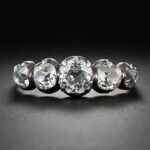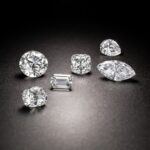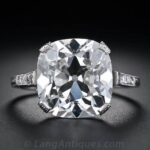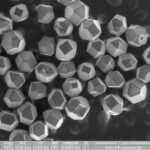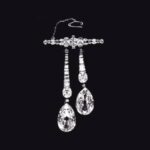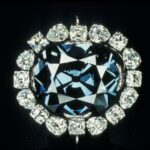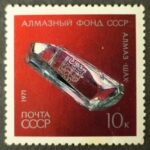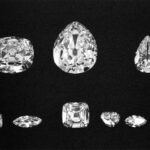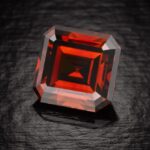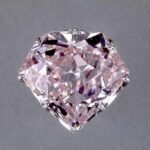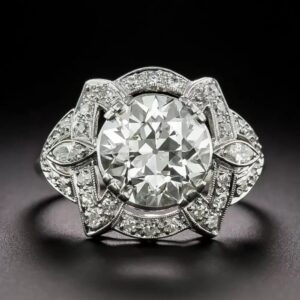
Diamonds are valued for their incredible brilliance and hardness. Diamonds are chemically pure carbon, identical to the graphite used for pencils. Diamonds’ hardness is the result of extremely strong chemical bonds between carbon atoms. Most people think of diamonds as being colorless, but they actually occur in every color. Colors like canary yellow, green, pink, blue, purple, and rare reds are termed “fancy” colors. Several colors can be artificially produced by treatment with combinations of irradiation and heat. Diamonds are extremely stable under normal conditions.
A Brief History of Diamond
Diamonds were treasured as talismans as early as 800 B.C. For more than 2,500 years India was the only known diamond supplier.
During the First Century A.D., it was the height of stature for prominent Romans to wear uncut diamonds, mounted in gold rings. These diamond talismans were awarded to a fortunate few by the emperor.
In the 13th century, Louis IX of France, proclaimed an order forbidding all women, including queens, to wear diamonds! He insisted that diamonds were only for Kings. This law was challenged 200 years later by the mistress of Charles VII, who is considered responsible for making diamonds popular to all members of the French court.
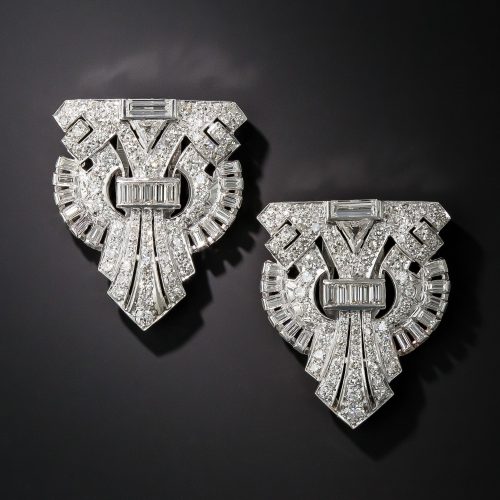
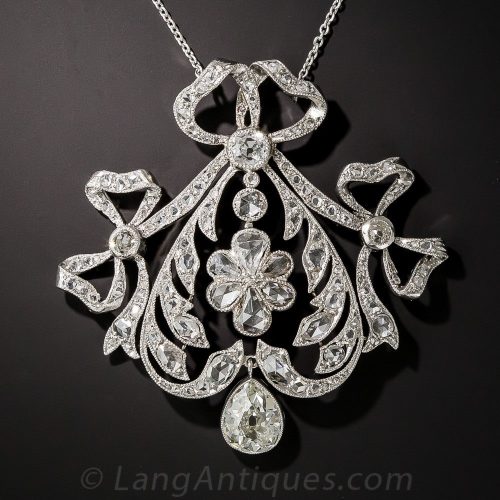
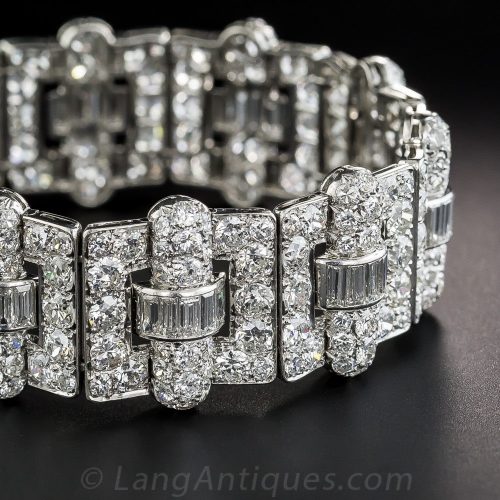
The first diamond engagement ring was given to Mary of Burgundy by Maximilian in 1477. For centuries it was believed that diamonds had gender. Francois Ruet, in 1566, described two diamonds as having offspring.
Diamond production in India began to taper off in the 1700s. In 1725, diamonds were discovered in Brazil, making it the world’s largest supplier. That changed in 1866 when diamonds were discovered in South Africa. In 1888, DeBeer’s Consolidated Mines, Ltd was formed and more than 100 years later they still boast control over 80% of the diamond trade in the world.
Diamond is the birthstone for April and commemorates the 10th and 60th Anniversary.
Shop at Lang
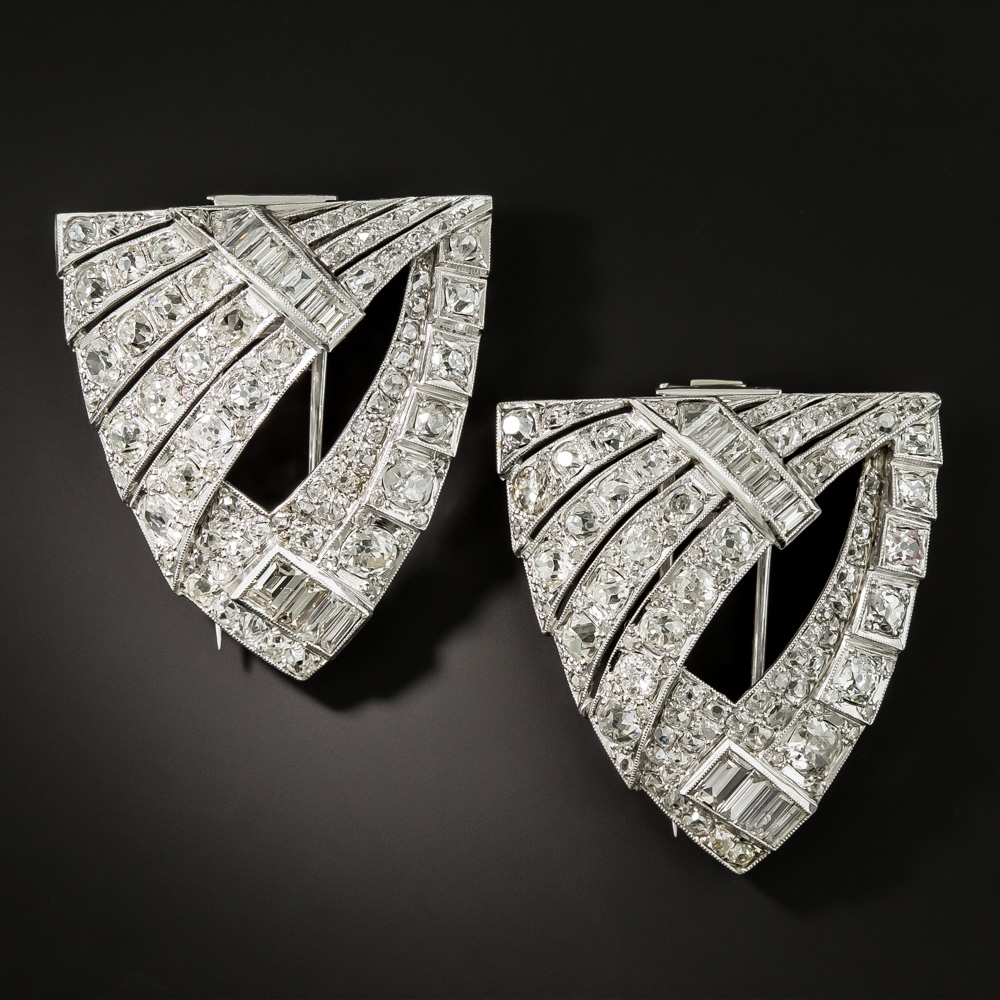
Large Art Deco Diamond Dress Clips
Wow is the word! These dynamic Art Deco dazzlers, distinctively fashioned as Reuleaux triangles (curved sides), sparkle intensely with sweeping platinum ribbons…
SHOP AT LANG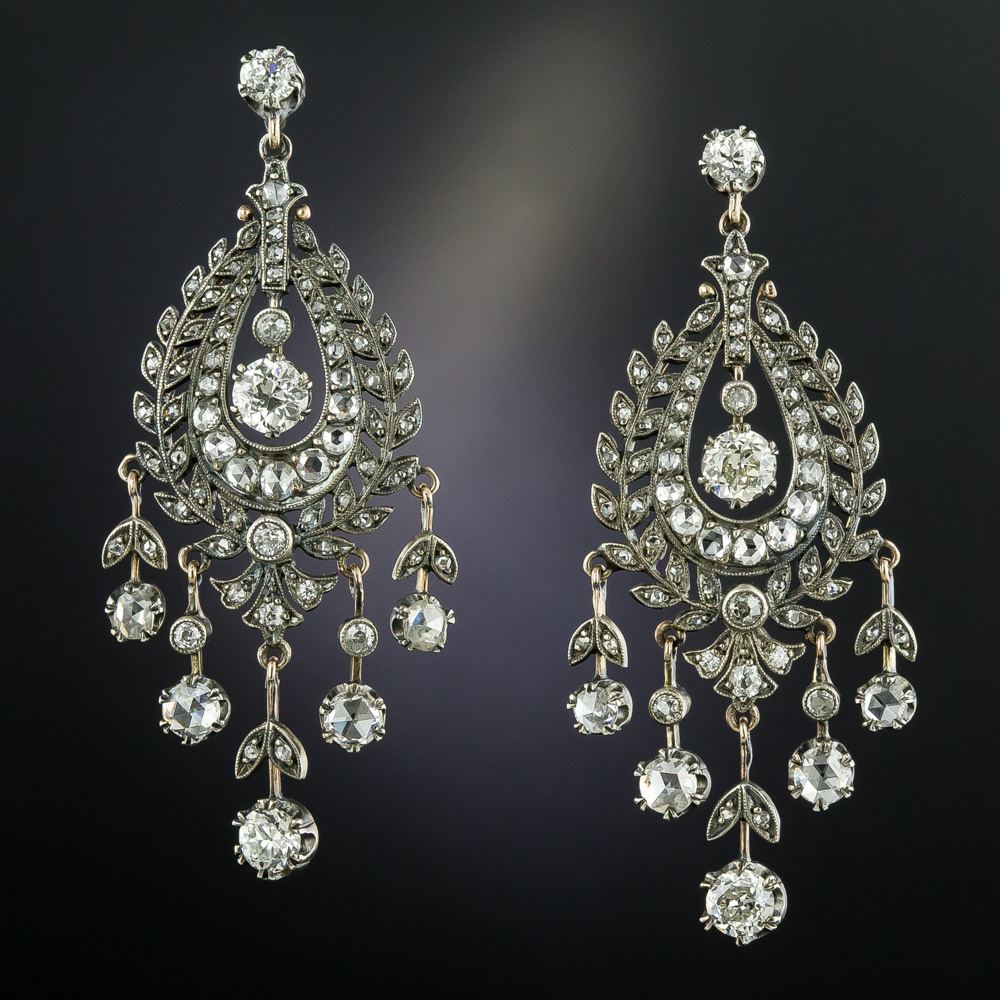
Victorian Diamond Silver over Gold Chandelier Earrings
Queen Victoria might have worn a pair of earrings like these on a more casual day--if there is such a thing for a queen. Hand fabricated in silver over 9ct. gol…
SHOP AT LANG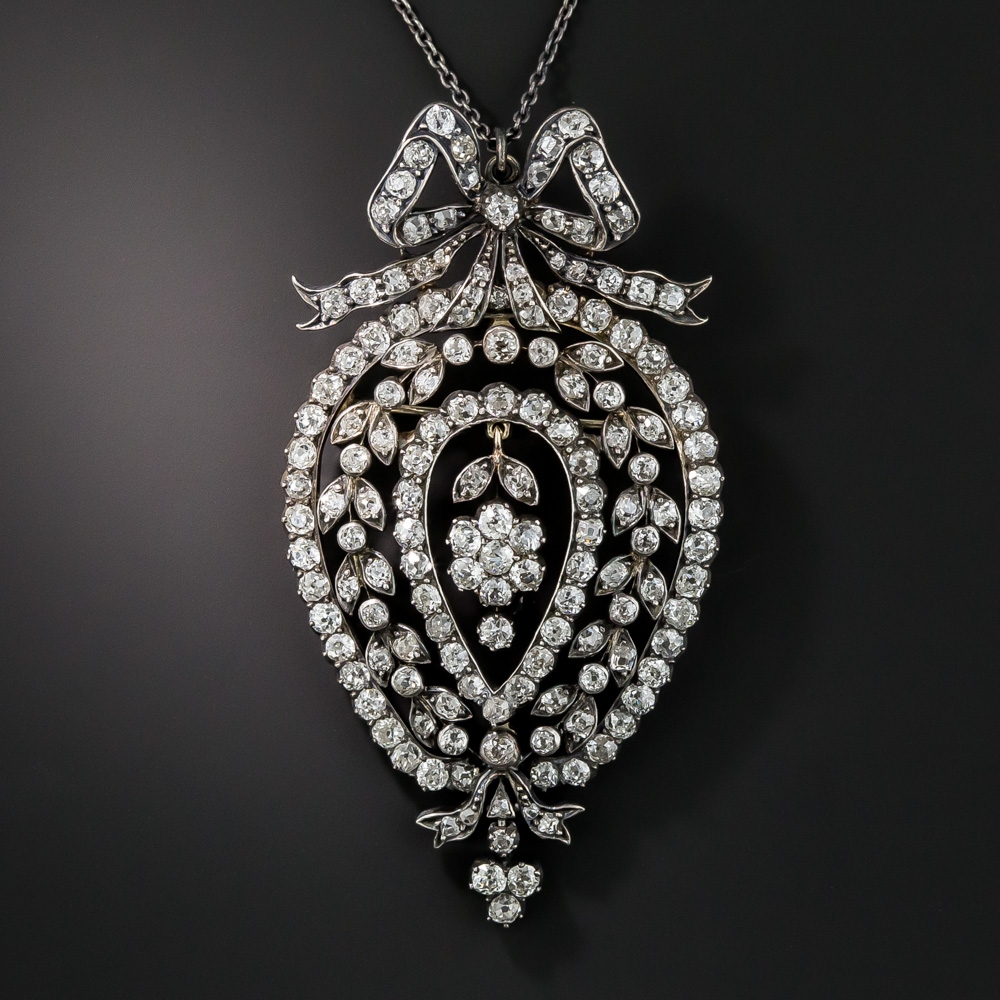
Late Victorian/Edwardian Diamond Pendant/Brooch
Late-Victorian/early-Edwardian jewelry mastery is in full flower with this breathtakingly beautiful bauble (wearable as both a necklace pendant or brooch), fine…
SHOP AT LANG
Gemological Information for Diamond
| Color: | All Colors |
| Crystal Structure: | Cubic |
| Refractive Index: | 2.417 |
| Durability: | Excellent |
| Hardness: | 10 |
| Family: | |
| Similar Stones: | Diamonds Can Be Confused with a Large Variety of Colorless Gemstones and Synthetic Gemstones: Zircon, Cubic Zirconia, Moissanite, YAG, Strontium Titanate, Leaded Glass, Rhinestone and Synthetic Rutile |
| Treatments: | Heat Treatment, Irradiation, Fracture Filling |
| Country of Origin: | Diamond Deposits are Found All Around the World. The Most Notable Being Africa, Australia, India and, More Recently, Canada |
Diamond Care
| Ultrasonic Cleaning: | Safe Unless the Stone is Fractured |
| Steam Cleaning: | Safe Unless the Stone is Fractured |
| Warm Soapy Water: | Safe |
| Chemical Attack: | No Reaction |
| Light Sensitivity: | None |
| Heat Sensitivity: | Diamond is an Excellent Conductor |
Related Reading
Explore our Collection of Essays on Famous Diamonds
Gems & Gemology: The Quarterly Journal of The Gemological Institute of America.
Diamond Localities
Africa:
- Winter 1946, The Premier and Jagersfontein Mines Reopened, p. 377, 1p.
- Spring 1949, Kimberlite Found in the Bakanga Diamond Field, Zaire, p. 131, 5pp
- Fall 1949, Diamond Mining in South Africa, p. 216, 4pp.
- Fall 1950, New Diamond Discovery from the Gold Coast, p. 349, 1p.
- Summer 1951, Diamond Mining in Tanzania, p. 76, 1p.
- Winter 1958, Diamond Mining in Southwest Africa, p. 232, 8pp.
- Winter 1963, The New Fincham Diamond Mine in S. Africa, p. 107, 5pp.
- Summer 1968, Mining on the Coast of S.W. Africa, p. 292, 6pp.
- Winter 1970, Koffyfontein Diamond Mine, S. Africa, reopens, p. 266, 2pp.
- Spring 1971, Diamond Mining in Botswana, p. 295, 4pp.
- Winter 1972, The Orapa Diamond Mine in Botswana Opens, p. 109, 2pp.
U.S.:
- Fall 1940, Arkansas Diamond Field, p. 109, 4pp.
- Fall 1941, Arkansas Diamond Mine Changes Hands, p. 168, 1p.
- Spring 1943, Arkansas Diamond Mine, p. 72, 1p.
- Fall 1944, The Punch Jones Diamond of Virginia, p. 169, 1p.
- Winter 1949, Another Rough Diamond Found in Indiana, p. 249, 2pp.
- Winter 1949, Diamonds in Arkansas, p. 257, 1p.
- Spring 1953, History of Diamonds in Wisconsin, p. 284, 2pp.
- Winter 1957, Diamond Mining in Arkansas (historic and recent), p. 355, 8pp.
- Summer 1959, Diamond Digging in Arkansas, p. 318, 1p.
- Fall 1959, A 3.65 ct. Diamond from Arkansas, p. 343, 1p.
- Spring 1960, a 6.45 ct. Diamond from Arkansas, by Harold Branch, p. 7, 3pp.
- Fall 1961, Wisconsin Diamonds, p. 210, 6pp.
- Winter 1961, Another Diamond Found in Arkansas (.83 ct., pictured), p. 245, 2pp.
- Summer 1968, A catalog of the Drift Diamonds of the Great Lakes Area, p. 297, 7pp.
- Fall 1968, p. 333, 2pp., with Large Bibliography
- Winter 1969, An 18.20 ct. Diamond Found in Louisiana—Mounce Diamond, p. 13, 1p.
- Fall 1977, Diamond Find in Arkansas, p. 349, 1p.
Other than Africa & U.S.:
- Winter 1942, Notes on Some Brazilian Diamonds, p. 55, 3pp.
- Winter 1943, Notes on Diamond Mines of India, p. 115, 2pp.
- Winter 1944, Russian Diamond Production, p. 184, 1p.
- Winter 1948, Diamond Find in Canada, Doubtful, p. 123, 1p.
- Winter 1949, Diamond Mining in Brazil, by T. Draper, p. 231, 12pp.
- Summer 1950, Origin and Sources of Diamonds in Brazil, by T. Draper, p. 298, 9pp.
- Summer 1950, Indian Diamond Pipe Described, Panna, p. 315, 1p.
- Fall 1950, Diamond Find in Quebec (?), p. 354, 1p.
- Summer 1951, The Diamond Mines of Diamantina, Brazil—Past and Present, by T. Draper, p. 49, 9pp.
- Fall 1951, p. 89, 10pp.
- Summer 1951, The Ungava Crater, Quebec, No Diamonds Found, p. 79, 1p.
- Winter 1954, Is Borneo Becoming an Important Diamond Source?, p. 126, 1p.
- Summer 1957, Diamond Possibilities in Colombia, p. 63, 1p.
- Fall 1960, A 33 ct. Diamond Found in Borneo, p. 93, 1p.
- Spring 1963, Diamond Mining in Brazil, by Draper, p. 12, 6pp.
- Summer 1963, p. 45, 5pp.
- Fall 1965, The Siberian Diamond Deposits, p. 342, 9pp.
- Winter 1965, p. 377, 3pp.
- Winter 1967, South American Diamonds and the World Diamond Market (Brazil, Guyana, Venezuela), by E. Miles, p. 226, 13pp.
- Winter 1967, First Brazilian Diamond Dredge, p. 239, 3pp.
- Winter 1970, The Russian Diamond Industry, by Liddicoat, p. 259, 7pp.
- Fall 1977, Diamonds in Brazil & Venezuela, by Sinkankas, p. 337, 3pp.
Diamond Gemology:
- March-April 1934, Diamond Loupes, by R. Shipley, p. 38, 2pp.
- May-June 1934, An Engraved Diamond, p. 75, 1p.
- -Dec. 1934, The Multiple Source Theory of the Diamond, by S. Ball, p. 156, 4pp.
- -Oct. 1935, Colored Diamonds, by S. Ball, p. 309, 3pp.
- Fall 1937, The Diamond, by Briggs, p. 127, 2pp.
- Winter 1937, p. 139, 2pp.
- Summer 1938, The Color of a Diamond, p. 174, 1p.
- Winter 1938, Radium-Treated Diamonds, p. 194, 1p.
- Summer 1941, A Glossary of Diamond Terms … (Aberration-Ballas), p. 151, 3pp.
- Fall 1941, (Bantam-Boort), p. 173, 2pp.
- Winter 1941, (Borneo-Bubbles), p. 182, 2pp.
- Spring 1942, (Bultfontein Mine-Clean), p. 13, 2pp.
- Summer 1942, (Cleavage-Cutting Centers), p. 29, 4pp.
- Fall 1942, (Cutting, History of-Dyke), p. 43, 4pp.
- Winter 1942, (Eclogite-Fracture), p. 59, 4pp.
- Spring 1943, (Fromesite Bort-Holland Rose Cut), p. 73, 4pp.
- Summer 1943, (Holohedral-Interference, Color), p. 95, 2pp.
- Fall 1943, (Intergrowth-Knot lines), p. 105, 4pp.
- Winter 1943, (Koffeyfontein Mine-Luminescence), p. 119, 6pp.
- Spring 1944, (Lumpy-Mill), p. 138, 3pp.
- Summer 1944, (Miller indices-Moon of the Mountains Diamond), p. 155, 2pp.
- Fall 1944, (Mora Diamond-Neck), p. 171, 2pp.
- Winter 1944, (Negative Crystals-Old Mine Stone), p. 191, 2pp.
- Spring 1945, (Onca-Orloff Diamond), p. 215, 2pp.
- Summer 1945, (Orloff Diamond, cont.-Parting), p. 237, 2pp.
- Fall 1945, (Parure-Perfect), p. 261, 2pp.
- Winter 1945, (Perfect, cont.-Pigot Diamond), p. 289, 3pp.
- Spring 1946, (Pink Diamonds-Point Naive), p. 315, 2pp.
- Summer 1946, (Polariscope-Porter Rhodes Diamond), p. 335, 2pp.
- Fall 1946, (Portrait Stone-Proper Proportions), p. 355, 2pp.
- Winter 1946, (Properties-Regent Diamond), p. 379, 2pp.
- Spring 1947, (Regent Diamond, cont.-Riviere), p. 409, 2pp.
- Fall 1941, Diamond Color Grading, p. 162, 7pp.
- Winter 1945, The Extreme Scarcity of Fine-Color Flawless Diamonds, p. 276, 7pp.
- Winter 1945, The new Colorscope Grades Color, p. 286, 2pp.
- Spring 1947, Fluorescent Diamonds, by Switzer, p. 392, 3pp.
- Spring 1947, The Abundance and Color of Fluorescent Diamonds, by Shipley, p. 395, 6pp.
- Summer 1947, Color Range and Form Variations in Diamonds, p. 430, 2pp., plus one color plate
- Fall 1947, The Two Types of Single Diamond Crystal Forms, p. 455, 7pp.
- Spring 1948, The History of Diamonds-King of Gems, by Ball, p. 18, 5pp.
- Winter 1948, Research Lab Erected in South Africa, p. 121, 2pp.
- Summer 1949, Radioactive Diamonds, p. 167, 4pp.
- Summer 1950, Bombarded Diamonds, by M. Ehrmann, p. 295, 4pp.
- Summer 1950, Sir William Crookes Treated Green Diamonds in 1914, p. 317, 2pp.
- Fall 1950, The Diamond Research Lab, S. Africa, p. 327, 7pp.
- Winter 1950, Recovery of Diamonds by Electrostatic Separation, p. 385, 2pp.
- Spring 1951, Recognizing Surface Irradiated Diamonds, by Pough, p. 3, 9pp.
- Spring 1954, Bombarded Diamonds, p. 29, 2pp.
- Summer 1954, Testing Natural Blue and Treated Blue Diamonds, p. 35, 3pp.
- Winter 1955, Microstructures of Diamond Surfaces, by Tolansky, p. 242, 8pp.
- Winter 1955, The Two Types of Diamond (I, IIa, lIb), p. 255, 1p.
- Summer 1957, Diamond Substitutes, by L. Benson (each discussed), p. 56, 5pp.
- Winter 1957, Spectroscopic Recognition of Yellow Bombarded Diamonds, by *Crowningshield, p. 99, 7pp., with Large Bibliography
- Winter 1957, Minor Elements in Diamonds and their Effect on Diamond Colors, p. 111, 4pp.
- Winter 1958, Treated Diamonds Show Very Strong Radiation, p. 230, 2pp.
- Spring 1959, Color Treating Diamonds by Neutron Surface Irradiation, Done in U.S., p. 266, 2pp.
- Spring 1959, Treated Red, Blue and Blue-Green Diamonds, p. 268, 2pp.
- Summer 1959, Coating Detected on a Marquise Diamond, p. 292, 2pp.
- Summer 1959, A Diamond, Fine Brownish-Yellow by Night and Green by Day, p. 293, 3pp.
- Summer 1959, A Simple Device to Test Blue Diamond Conductivity, p. 296, 3pp.
- Winter 1959, Gold Mountings Break in Strong Bleach, p. 358, 2pp.
- Summer 1960, Pink Diamonds Change Color in X-ray, p. 45, 2pp.
- Summer 1960, An Audio Conduction Detector for Type lIb Diamonds, p. 49, 2pp.
- Fall 1960, Green Diamonds (Radium Treated), p. 69, 2pp.
- Winter 1960, Diamonds Burned in Fires, p. 118, 2pp.
- Summer 1961, Natural Yellow Diamonds (Including Spectrum), p. 184, 2pp.
- Winter 1961, Artificial Coloration of Diamonds, p. 227, 15pp., with Large Bibliography
- Winter 1961, An Autoradiograph of a Radium-Treated Diamond, p. 242, 2pp.
- Summer 1962, Diamond Doublets, p. 305, 2pp.
- Summer 1962, The Surface Structure of Diamonds, p. 309, 6pp.
- Fall 1962, Determining Origin of Colors in Diamonds, p. 344, 1p.
- Winter 1962, Diamond Coating Techniques and Their Detection, by E. Miles, p. 355, 11pp.
- Winter 1962, Diamond and Synthetic Sapphire Doublet, p. 379, 2pp.
- Spring 1963, A Grayish-Yellow Type IIb Diamond, p. 24, 2pp.
- Spring 1963, Cyclotron-Treated Diamond, p. 26, 1p.
- Fall 1963, Orange Cyclotron-Treated Diamond, p. 82, 1p.
- Fall 1963, Conductivity of Blue Diamonds, p. 84, 2pp.
- Spring 1964, Diamonds Burned in Fires, p. 149, 2pp.
- Spring 1964, A Hollow back Diamond in Closed Molded Setting to Simulate Pavilion, p. 150, 3pp.
- Spring 1964, Pink Diamonds and their Characteristics, p. 155, 1p.
- Summer 1964, Coated Diamonds, by E. Miles, p. 163, 6pp.
- Summer 1964, A Cross of Diamond Doublets, p. 181, 1p.
- Winter 1964, Twin Lines and Crystal Growth Lines, p. 252, 1p.
- Spring 1965, “Piggy-Back” Mounted Diamonds, One Over the Other, p. 262, 3pp.
- Winter 1965, A Natural-Color Deep Green Diamond, p. 362, 1p.
- Winter 1965, A Natural-Color Deep Green, a Blue and a Red Diamond, p. 362, 1p.
- Winter 1965, “Piggy-Back” of Three Layers, Not Touching (First Time Seen), p. 362, 2pp.
- Spring 1966, Diamonds Show Discoloration After Repeated Washing in Hard Water, p. 22, 1p.
- Summer 1966, A Rose Cut Diamond (14½ x 6mm) in Ccarved Cclosed Mmetal Ssetting Iimitating Llarge Diamond, p. 43, 2pp.
- Fall 1967, Rare Light-Blue Diamonds, Type IIb, p. 209, 2pp.
- Winter 1967, Brown Diamonds and their Inclusions, p. 249, 2pp.
- Summer 1968, Radium-Treated Diamonds, p. 304, 2pp.
- Fall 1969, Spectrum of a Natural Gray Diamond, p. 89, 2pp.
- Winter 1969, Cyclotron-Treated Diamonds Detected Only by Microscope, p. 125, 2pp.
- Winter 1969, An Unusual Spectrum Seen in a Yellow-Brown Diamond, p. 126, 2pp.
- Summer 1970, A Bicolored Marquise Diamond (Outside Rim, Yellow-Green; Center Area, Medium Red), p. 182, 2pp.
- Fall 1970, Ultra-Violet Light in D to G Color Diamonds, p. 226, 1p.
- Winter 1970, The Facts about Diamond Imitations, p. 245, 4pp.
- Spring 1971, Russian Diamonds, p. 285, 2pp.
- Spring 1971, Diamond Top, Zircon Back Doublets, p. 287, 1p.
- Spring 1971, Determining a Black Diamond Natural or Treated, p. 287, 2pp.
- Fall 1971, Burning (Oxidizing) Rough Diamond Crystal to Improve Surface Color, p. 345, 1p.
- Winter 1971, Diamond and Zircon (or Strontium Titanite, Spinel, etc.) Doublets, p. 375, 2pp.
- Winter 1971, Diamonds Treated Pink, p. 380, 1p.
- Spring 1972, A Piggy-Back Setting, p. 9, 2pp.
- Summer 1972, A 30 ct. Black Diamond, p. 41, 2pp.
- Summer 1972, A Large Hexagonal Rose Cut Diamond Set with Foiled Pavilion, Closed Back, p. 54, 1p.
- Fall 1972, 25 Years of Diamond Research by De Beers Industrial Diamond Div., p. 66, 11pp.
- Fall 1972, Diamonds Treated to Intense Yellow and Blue Colors, from Mass., p. 82, 2pp.
- Fall 1972, Diamonds Burned in Fires, p. 89, 3pp.
- Winter 1972, Banded diamonds and clarity; Type lIb diamonds, p. 106, 2pp.
- Winter 1972, Diamond Doublets, p. 107, 2pp.
- Fall 1973, Unusual Fluorescence in a Diamond, p. 200, 1p.
- Spring 1975, An Intense Natural Canary, no Absorption Lines, p. 17, 2pp.
- Summer 1975, A Black Diamond with a Colorless Center, p. 47, 2pp.
- Summer 1975, A Diamond Burned in Repair Work, p. 57, 2pp.
- Summer 1975, A “Chameleon Diamond” (Shows Color Change), Dark Yellow-Green to Yellow; 3rd seen at GIA, p. 57, 2pp. (Type l lb. Diamond May or May not Loose Conductivity when Treated.)
- Fall 1975, An Unusual Cyclotron-Treated Diamond, Shows Color Line, p. 72, 2pp.
- Winter 1976, Cape Diamond Painted Blue, p. 124, 2pp. (See also Summer 1976, p. 183, 1p.)
- Spring 1976, Cubic Zirconia, A New Diamond Imitation, p. 143, 2pp. (See also Spring 1976, p. 154, 2pp.)
- Summer 1976, A Cyclotron-Treated Emerald-Cut Green Diamond, p. 171, 2pp.
- Summer 1976, A Diamond Turned Yellow by Washing in Hard Water, p. 182, 2pp.
- Summer 1976, A Complete Spiral Scratch on a Diamond’s Table, of Unknown Origin, p. 185, 1p.
- Fall 1976, Zirconium Oxide, a Diamond Simulant, p. 221, 2pp.
- Winter 1977, Cape Lines Missing in “True Canary,” p. 235, 1p.
- Summer 1977, Notes on Treated Pinks, Blacks, and Brown IIb’s, p. 306, 2pp.
- Summer 1977, Conchoidal Fracture in Diamonds, p. 309, 2pp.
- Fall 1977, Cubic Zirconia; Moss Patched on the Surface of Radium Treated Diamonds, p. 345, 3pp.
- Winter 1977, More on Cubic Zirconia, p. 361, 3pp.
- Winter 1977, Colors of IIb Diamonds; a Light Greenish-Blue IIa Diamond; an Intense 5400Å Line in Intense Yellow-Brown Diamond, p. 363, 2pp.
- Summer 1978, Cubic Zirconia (Show Colored Material), by R. T. Liddicoat, Jr. and J. I. Koivula, p. 58, 3pp.
- Fall 1978, Laser Reflection Patterns in Diamond and Diamond Substitutes, by Eunice R. Miles, p. 77, 8pp.
- Fall 1978, The New Gem Diamond Testing Pen, by Rick Shaw, p. 92, 4pp. (Also Shows Water Drop Test) (See also Jour. of Gemmo., July 1981, p. 446, 3pp.)
- Winter 1978, The Ceres Diamond Probe Test for Diamond Substitutes, by K. Nassau, p. 98, 6pp.
- Winter 1978, Distinguishing Diamond from Cubic Zirconia, Old and New Tests, by K. Nassau, p. 111, 7pp.
- Winter 1978, Two Interesting Treated Diamonds (Radium Treated Color a Dark Tourmaline-Like Yellowish Green), p. 125, 2pp.
- Spring 1979, Cubic Zirconia, Notes, p. 148, 3pp.
- Spring 1979, Testing Blue and Pink Diamonds in the Spectroscope, p. 150, 1p.
- Spring 1979, Coated Cubic Zirconia Passed Ink Test, p. 150, 1p.
- Spring 1979, Using Cryogenics to Test Green Diamonds and Treated Brown Diamond with a 6400A.U. Line, p. 151, 1p., and see p. 154, 1p.
- Spring 1979, Green Diamond Owes Color to Graining, p. 154, 1p.
- Spring 1979, Fashioning Cubic Zirconia, by Bill Kerr, p. 155, 3pp.
- Fall 1979, High Color Small Diamonds, p. 200, 2pp.
- Fall 1979, Size and Diamond Grading Color, p. 200, 3pp.
- Fall 1979, The Size and Weight of Diamond and Diamond Imitations, by K. Nassau, p. 203, 2pp.
- Winter 1979, Know Your Diamonds, More Books on Diamonds (Refers to “Gill’s Index”), by Betsy Barker, p. 247, 7pp.
- Summer 1980, A Black Rose Cut Diamond, p. 321, 1p.
- Winter 1980, Seldom Seen Absorption Spectra in Diamonds, p. 392, 1p.
Laser Treatment:
- Fall 1970, Lasering Diamonds, First Done, p. 224, 3pp.
- Winter 1971, Improved Lasering Techniques for Diamonds, p. 370, 2pp.
- Spring 1972, Laser Drilling Diamonds, p. 21, 2pp.
- Summer 1972, Laser Drilling Diamonds, p. 56, 3pp.
- Fall 1972, More on Laser Drilling Diamonds, p. 89, 3pp.
- Winter 1972, A Deep Laser Hole, p. 114, 1p.
- Spring 1973, Interesting Laser Drilling, p. 139, 2pp.
- Spring 1973, Attitudes Toward Laser Drillings, p. 144, 2pp.
- Winter 1973, Many Laser Holes in One Diamond, p. 230, 2pp.
- Winter 1976, Seventeen Laser Drill Holes in One Diamond, p. 124, 1p.
Diamond Inclusions:
- Winter 1947, A Diamond in a Diamond, by Liddicoat, p. 492, 2pp.
- Fall 1950, A Diamond in a Diamond the Slijper Diamond, p. 347, 2pp.
- Spring 1952, Unusual White Cloudy Bands from Corner to Corner in Three Directions in an Octahedron Diamond Crystal (on Cover) (See also Summer 1966, p. 40, 2pp.)
- Summer 1963, Diamond Inclusions, p. 51, 4pp.
- Fall 1964, Needle-Like Inclusions in a Diamond, p. 218, 1p.
- Spring 1965, Needle-Like Inclusions in Diamonds, p. 268, 2pp.
- Spring 1965, Typical Cloud in Natural-Colored Brown Diamonds, p. 269, 2pp.
- Winter 1965, Rare Moss-Like Inclusions in Diamond; and Other Inclusions, p. 364, 1p.
- Fall 1966, Rare Moss-Like Inclusions in Diamond, p. 72, 2pp.
- Spring 1967, Sugar-Cube-Like Inclusions in Diamond, p. 137, 2pp.
- Spring 1967, Sugar-Cube-Like Inclusions in Diamond (from Sierra Leone), p. 146, 2pp.
- Spring 1967, Rounded Crystal Inclusions and a Maltese Cross Inclusion, p. 154, 2pp.
- Spring 1968, First Fingerprint Inclusions, First Needles (in Three Directions) Inclusions in Diamond, Seen at GIA, p. 278, 2pp.
- Fall 1968, Sugar-Cube-Like Inclusions Under High Magnification, p. 344, 2pp.
- Fall 1969, Color Banding in a Treated Yellow-Brown Diamond, p. 92, 2pp.
- Spring 1970, Needle-Like Inclusions in Diamond (Almost a Star), p. 153, 1p.
- Spring 1970, Milky White Diamond, p. 156, 2pp.
- Spring 1971, Graining in Diamond, p. 286, 1p.
- Spring 1971, Crazed Diamond Surface, p. 286, 1p.
- Fall 1971, Graining in Diamonds. and Grading Problems, p. 344, 2pp.
- Fall 1971, Tomahawk Shaped Knot on a Brilliant Diamond Table, p. 345, 2pp.
- Fall 1971, Square Graining, and Clarity Grading Ranges, p. 360, 2pp.
- Winter 1971, Rare Diamond Inclusions, p. 372, 2pp.
- Winter 1971, Graining in Clarity of a Large Green Diamond, p. 385, 1p.
- Spring 1972, Surface Graining Shows on Facet Polish, p. 11, 2pp.
- Spring 1972, Grain and Growth Lines in Diamonds, p. 22, 2pp.
- Fall 1973, An Interesting Cross Inclusion in a Diamond, p. 201, 2pp.
- Fall 1974, A Moss-Like Inclusion in a Diamond, p. 331, 2pp. (See also Winter 1983, p. 233, 1p.)
- Fall 1974, A Nail-Like Inclusion in Diamond, p. 340, 2pp.
- Fall 1974, A Lifelike Bug Inclusion in Diamond, p. 342, 1p.
- Fall 1974, Needles, and Octahedral Diamond Crystals Included in Diamonds, p. 347, 2pp.
- Fall 1975, A Treated Green Diamond with a Maltese Cross, p. 76, 1p.
- Fall 1975, A Sugar-Cube-Like Inclusion with Protruding Needle, p. 76, 2pp.
- Winter 1976, A Two-Phase Inclusion, Liquid and Gas, in a Diamond, p. 114, 1p.
- Summer 1976, Spherical Bubble-Like Inclusions in a Diamond, p. 183, 2pp.
- Fall 1976, A Brown Diamond Shows Very Knotty Table, p. 213, 1p.
- Fall 1976, Laser Holes and Damage to Diamonds, p. 218, 2pp.
- Fall 1976, A Centipede-Like Inclusion in a Diamond, p. 219, 1p.
- Winter 1976, Excessive Lasering, p. 233, 1p.
- Summer 1977, Clarity Rules on Graining, p. 297, 3pp.
- Summer 1977, A 6-Rayed Snowflake Inclusion, p. 307, 2pp.
- Fall 1977, Analytical Results of Poly-Mineralic Sulfide Inclusions in Diamond, Gübelin, p. 322, 6pp.
- Winter 1978, Worm-Like Inclusions in Diamond, p. 364, 1p.
- Fall 1979, Interesting Diamond Inclusions and Characteristics, p. 196, 5pp
- Fall 1979, Cubic Cloud and Octahedron Cloud, Natural Cube Rough, Green Graining, & Feather, p. 209, 5pp.
- Fall 1979, Green Grain Line in High Color Diamond, p. 210, 1p.
- Spring 1980, Sugar Cube and Crystal Inclusion, p. 265, 2pp.
- Summer 1980, The Elusive Nature of Graining in Gem Quality Diamonds, by Robert E. Kane, p. 294, 21pp.
- Winter 1980, Epigenetic Stains in Diamonds & Clouds in Diamonds, p. 397, 3pp.
- Winter 1980, Phantom Crystal in a Diamond, p. 410, 2pp.
